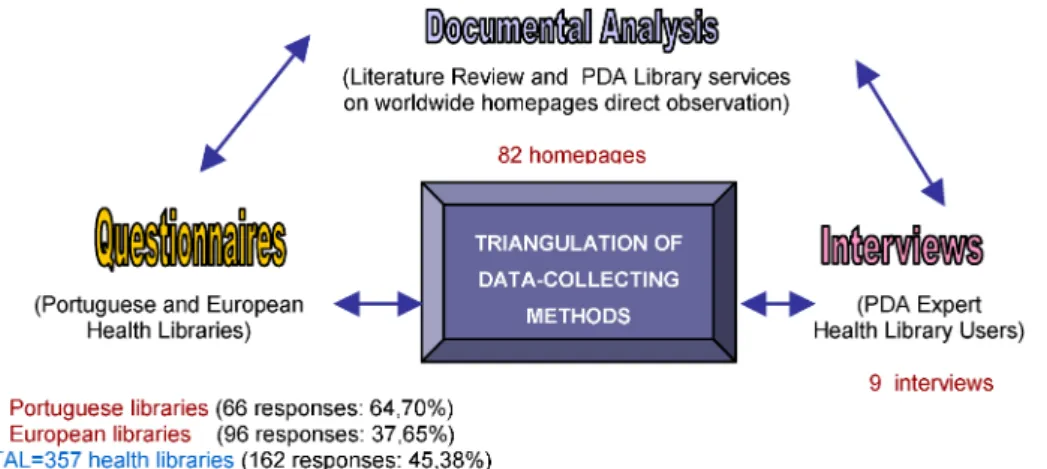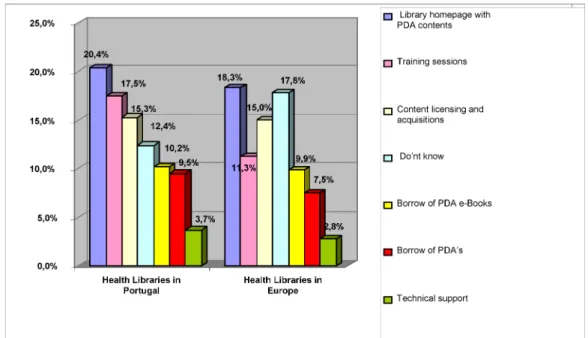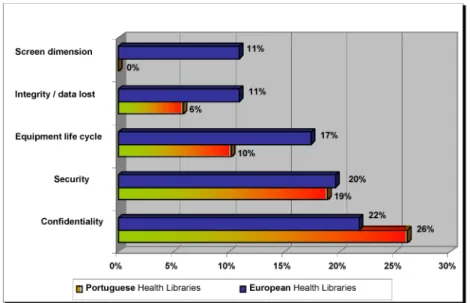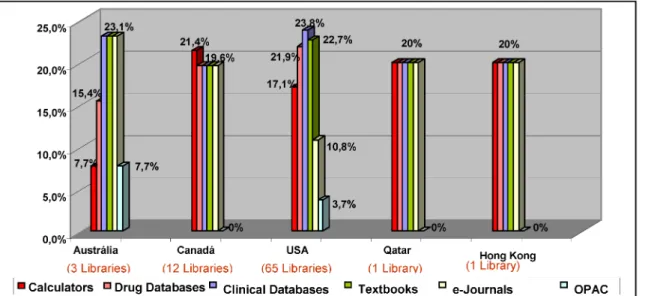Medicine, Main Library, Lisbon, Portugal decision-making for their patients, has became a serious problem to
this group of health professionals, claiming more often to have close to them, a portable library open 24 hours a day.
Personal Digital Assistants (PDAs) have been successfully introduced into the health libraries environment and give the users the opportunity to have the most recent and scientific information “in the palm of their hands”. The main objective of this study was to contribute to the imple- mentation of user reference services based in PDAs, in Health Libraries in order to guarantee our health professional users, autonomy and mobility in their work places near the patients. We aim to know, if the European Health Libraries, are fully aware of the strengths and power of these new type of PDA-based services, giving them the chance to offer the adjusted help to this new user needs. The methodology used is based on online surveys, submitted to Portuguese and European Health Libraries, and by interviews conducted with a group of selected health expert PDA users in medicine. We concluded that using PDAs is the future in medicine and the new mission of health libraries is to offer services based on mobile technologies such as PDAs, if they want to serve their users with excellence.
Keywords:PDA, Personal Digital Assistant, handheld computer, Palm, PocketPC, mobile library, electronic medical information, medical informatics, mobile health technology, health libraries survey
Zusammenfassung
Die Benutzer von Medizinbibliotheken haben einen zunehmenden Bedarf an genauer, aktueller, evidenzbasierter und mobiler Information in ihrem klinischen Arbeitsalltag. Die Forderung nach weniger Diagnosefehlern, mehr Zeiteffizienz und optimaler Patientenbehandlung entwickelt sich zu einem echten Problem für diese Berufsgruppe im Gesundheitswesen.
Oftmals wünschen sie sich desshalb eine mobile Bibliothek, die rund um die Uhr offen hat. Der Personal Digital Assistant (PDA) wurde im Umfeld der Medizinbibliotheken schon erfolgreich eingeführt. Er gibt den Benutzern die Möglichkeit, die aktuellste wissenschaftliche Infor- mation buchstäblich in der Hand zu haben.
Die durchgeführte Studie beschäfftigt sich haupsächlich mit der Imple- mentierung von Informations- und Nachschlagequellen für die Installa- tion am PDA durch Medizinbibliotheken. Damit kann den Professionisten im Gesundheitsbereich mehr Autonomie bei der Arbeit am Krankenbett zugesichert werden. Die Studie sollte auch feststellen, wieweit in den europäische Medizinbibliotheken die Chancen, Mittel und Möglichkeit von PDA-basierten Serviceleistungen bereits bekannt sind, um letztend- lich den oben genannten, neuen Bedürfnissen der Bibliotheksbenutzer zu entsprechen.
Die Studie wurde mit Online-Fragebögen an portugiesischen und euro- päischen Medizinbibliotheken durchgeführt. Weiters wurden Interviews
mit ausgewählten Gesundheitsexperten durchgeführt, die auch selbst den PDA in der Medizin verwenden. Die Studie kommt zum Schluss, dass die Verwendung des PDAs die Zukunft in der Medizin sein wird.
Damit wird es eine wichtige neue Aufgabe für Medizinbibliotheken sein Dienstleistungen für Mobilgeräte anzubieten, um ihren Benutzern wei- terhin ein exzellentes Service zu bieten.
Schlüsselwörter:PDA, Personal Digital Assistant, Palm, PocketPC, mobile Bibliothek, elektronische Gesundheitsinformation, Medizininformatik, mobile Medizintechnik, Umfrage an Medizinbibliotheken
Introduction and aim of the study
The action plan"Europe 2005 - One information society for all”, implemented by the Commission of the European Communities [1] on May 28th 2000, established as a priority the stimulation of secure services, applications and content based on a widely available broadband infra- structure. One of the key targets was to provide online health services (e-health) and to connect healthcare to broadband.
In April 2004 the Commission of the European Commu- nities mentioned in “e-Health - making healthcare better for European citizens” [2] on page 8:
“The priority of medical professionals is to offer best quality care within available resources and, above all – according to the Hippocratic oath – while doing no harm to the patient (primum non nocere). However, unfortunately, medical errors still occur. Some of these might be avoided by making good use of e- Health systems that can provide vital information, alerts, and make best practices, expert advice and results of clinical treatment more widely available.
e-health tools and applications can provide fast and easy access to electronic health records at the point of need. They can support diagnosis by non-invasive imaging-based systems. They support surgeons in planning clinical interventions using digital patient specific data, provide access to specialized resources for education and training, and allow radiologists the possibility to access images anywhere. Thus, the workplace is being redefined and extended.”
PricewaterhouseCoopers also referred in "Healthcast Tactics: A Blueprint for the future" [3] on page 28:
“Most patient care decisions are made at the point of care. Physicians and nurses frequently must make critical decisions with incomplete information. Mobile computing has the potential to have the biggest im- pact on users actions and can therefore have the largest effect on productivity, efficiency and quality of care.”
The conscience about the power and advantages that these new emerging technologies can have on serving the health communities and the health professionals encourage a favorable environment for the increment of mobile technologies in health services.
Health Libraries must play an important role inside hos- pitals and medical schools giving doctors and students
support to achieve accurate and up to date information for their decision making near the patients.
In the last few years health library users felt more often the problem to obtain the most up to date information 24 hours a day, seven days a week, when they try to help their patients in clinical practice. Health information users need library services available at anytime and anywhere.
A library “without walls” open 24 hours.
This problem felt by doctors could be a new opportunity of intervention for health libraries by introducing new reference services based on mobile technologies such as Personal Digital Assistants (PDAs).
Why choosing PDAs for these new services? Because many health library users already have their own PDA, Smarthphone or iPhone, but they are not aware of the powerful midget health library they could hold in their hands. Health library users have to be advised about available free medical software and how to use the fea- tures of their equipment to help their decision-making near the patients. Health libraries can perform a new role in this area showing new horizons to solve the lack of in- formation in front of patients when doctors and medical students seek for specialized information but can’t go to library.
The main objective of this study was to increase the im- plementation of PDA-based services in health libraries in order to guarantee health professional users autonomy and mobility at their work places near the patients. Fur- thermore we wanted to know if the European health lib- raries are fully aware of strengths and power of these new services based on PDAs and which health libraries in Europe are currently implementing PDA services [4].
Method
For this study we sent online questionnaires to European health libraries and set up interviews with PDA expert health library users. Furthermore a literature review was was done and health library homepages presenting PDA services were analyzed directly. Quantitative and qualita- tive methods were applied since Gorman and Clayton [5]
recommend to use multiple research strategies and trian- gulating data to obtain accurate results (Figure 1): “By triangulating data-collecting methods, especially by using a quantitative method in conjunction with a qualitative method, the researcher is able to draw on the unique strenghts of each”.
Figure 1: The study used online questionaires, literature review combined with homepage analyzes and PDA expert interviews (triangulation of data-collecting methods).
Figure 2: Questionaires received from Portuguese and European health libraries (by country)
Results
From 357 questionnaires, sent between March and Au- gust 2006 to Portuguese and European health libraries, 162 libraries (45.38%) from 27 different countries re- sponded (Figure 2).
Almost all European libraries (90.6%) responded that they don’t offer PDA reference services to their users. Only 9 libraries (9.38%) have answered affirmatively. The Clinical Sciences Library at University of Leicester was the first European library starting with PDA services in 2002.
Concerning the portuguese libraries 94% don’t have PDA services. Only four libraries answered affirmatively. The first one started to implement PDA services in 2004 (Figure 3).
Health libraries without PDA services
Why do health libraries not implement PDA services?
31.43% of health libraries in Portugal consider this ser- vices as too expensive for their budgets (Figure 4).
28.57% don’t know this type of services and 21.43%
think that their library team is not prepared and needs training. 26.92% of European health libraries don’t know this type of services. 22.12% agree that these are expen- sive services and 16.35% think their library staff needs training. All libraries without PDA services consider other projects more important than developing PDA services.
Libraries were asked if they plan to start PDA projects in the future and if so, what type of PDA services they will offer (Figure 5).
A library homepage with PDA content is the prefered an- swer (20.4% in Portuguese health libraries and 18.3% in
Figure 3: PDA services at health libraries (countries and implementation year)
Figure 4: Reasons why health libraries don't offer PDA reference services European health libraries) followed by user training ses-
sions (17.5% and 11.3% respectively) and content licens- ing and acquisitions (15.3% and 15% respectively).
Technical support and loaning of PDAs and e-books are not high up on the agenda because these services require better trained human resources to give appropriate sup- port. Moreover it requires high investments into equip- ment and maintenance.
Health libraries with PDA services
According to the study nine European health libraries offer PDA services and four Portuguese health libraries are implementing it. The Clinical Sciences Library at University
of Leicester was the first library to implement PDA refer- ence services in Europe. In 2002 they started an initial project entitled:“Knowledge in the palm of your hands:
PDAs in the clinical setting”.
In 2004, for the first time in Portugal, the medical library at the Lisbon Faculty of Medicine made PDA content available on its library portal.
Library homepages with PDA resources (Figure 6) seem to be the preference at all libraries with PDA reference services: 43% in Portuguese libraries and 15% in European libraries. Licensing and acquisition of PDA re- sources and PDA training sessions are next: 14% for Portuguese libraries and 12% for European libraries.
Loaning of PDAs and e-books, infrared beaming stations
Figure 5: Type of PDA services libraries plan to implement in prospective PDA projects
Figure 6: PDA reference services available at health libraries in Europe and Portugal and technical support are PDA services not available at
all in Portuguese health libraries. A library catalogue in PDA format is a service offered only at 4% of the European health libraries.
As can be seen in Figure 7 health librarians still have se- curity concerns about clinical information on PDAs. Con- fidentiality of clinical patient data and security of informa- tion stored on PDAs are still a problem and main concerns using PDAs in the clinical settings.
Figure 8 compares medical PDA resources installed on PDAs of expert users and PDA resources offered by health
libraries. Drug references and clinical databases are fa- vorite products on both sides.
Health libraries' hompage analysis
Fox [6] affirms that “Librarians have always been early adopters of new technology at the forefront of effective utilization. Patrons, whether in public, academic or special libraries, rely on librarians to envision uses of new tech- nological developments. Librarians are evaluators and
Figure 7: Concerns about PDAs, security and clinical data
Figure 8: PDA resources installed on PDAs of expert users and PDA resources offered by health libraries in Portugal and Europe instructors, and PDA technology is a logical and necessary
extension of this role we’ve always played”.
In addition to the European PDA health libraries we de- tected in a worlwide internet survey 82 health libraries offering PDA resources and services on their homepage (Table 1).
The most common services for PDAs found on their homepages are:
• Library web pages offering PDA resources (29%)
• Helpdesk services/ask a librarian services via SMS, email and chat (15%)
• Training sessions (12%)
• Technical support (7%)
Table 1: Distribution and number of health libraries offering PDA resources and services beyond Europe
Figure 9: PDA resources availaible on health library homepages (beyond Europe) Table 2: User SWOT analysis of PDAs in clinical practice
The most common PDA resources found are shown in Figure 9.
Clinical databases are the most common resource avail- able on health libraries homepages, except in Canada, where medical calculators are the most prevalent re- source. The second place goes to textbooks followed by drug databases and e-journals. In Australia (7.7%) and USA (3.7%) libraries made their OPAC available in PDA format.
User SWOT analysis
Results from interviews with expert users were very positive. They think that using PDAs in medicine will be the next step in future and an irreversible process. Librar- ies should be aware of this and should follow this new user tendency because doctors need to have relevant information in the palm of their hand when they have to take an important decision at the point of care.
Age of the inquired doctors spans from 22 years to 63 years. From the interviews it can be concluded that age is not a barrier using PDA technology. Actually the oldest doctor was the most enthusiastic one using PDAs in medicine since 10 years.
All interviewed PDA users agreed that libraries can play an important role giving users new resources and training.
The aim of the SWOT analysis was to find out the expert user's opinion about PDAs in clinical practice (Table 2) and the benefits of PDA reference services in health lib- raries (Table 3).
Discussion
Mobile technology will take a prominent place in the clinical practice. If in the future health libraries refuse to offer services based on this emerging new technology others will do so. In the beginning this type of services
Table 3: SWOT analysis of PDAs reference services in health libraries
Figure 10: A range of possible PDA resources and services that could be offered by health libraries will be of interest only to a small group of users but then
this user group and its need will grow gradually. A health library with the vision and courage to implement PDAs will build up powerful and valuable services for users and benefits from beeing pioneer in this field.
Health libraries have to introduce mobile technology in the library with creativity and dynamism. From a variety of opportunities they can choose appropriate library ser- vices for PDAs (Figure 10). Lovett [7] refers that“Wireless technology is becoming more affordable and many health care institutions are going wireless. Librarians will be able to communicate directly with their patrons through the PDA and beam requested information or even chat
through the PDA. Understanding and supporting this technology will be the next area of evolution for the PDA librarian.”
Nevertheless, introducing PDA services in a health library environment still carries some challenges such as:
• Technical problems due to different operating systems (PalmOS, Windows Mobile, Symbian, Linux, RIM, Apple)
• Software licence negotiations
• Security measures
• Costs (acquisitions, human resources, training, mar- keting of new services)
operating system, different types of medical software and services). Based on quality and credibility they have then to decide on the right PDA services for their specific needs. Cuddy [8] mentioned that initially the development of library collections for PDA users could bring some diffi- culties and new challenges because there are different models for the acquisition of PDA software. Institutional licenses allow the users (or not) to download (temporary or for a certain time span) acquired PDA applications to their mobile decive. Several types of operating systems for the same product or different types of memory expan- sion cards (SD cards, CF cards, etc) present a new chal- lenge for librarians who have to choose adequately to their users' profile. Moreover librarians have to be able to choose which kind of PDA content is adequate for their user group, eg. e-books, e-journals, clinical databases, medical calculators and software for the management of clinical patient data.
Cuddy [8] says“It is difficult to put together a compre- hensive list of PDA software for libraries; new titles are frequently introduced and software may go through various version revisions and name changes. Libraries should work with their resource vendors to keep abreast of changes in existing products and to help them de- termine what content is currently available or expected for release.”
There is a way to decide more precisely on PDA services and resources which are available at the market and useful to patrons. Health librarians should carry out studies in order to estimate and better understand the real needs of their users in this new area. Based on these study results they can develop guidelines for the acquisi- tion of PDA resources, decide on the supported operating systems within their institution and specify the types of licences for PDA software (eg. unlimited number of downloads, acquisition of e-books on SD cards, etc.) From the results of our inquiries in Portuguese and European health libraries we can conclude that the exist- ence of mobile technology services based on PDAs is an unknown territory. Most libraries still ignore the advan- tages of PDA technology in medicine. Some health librar- ies know about the advantages of this type of service but have set other priorities. Yet they consider PDA services as too expensive for their budgets concerning the small number of PDA users at their university. Security and
such as document conversion, OPAC for the PDA, library navigation system (SmartLibrary at the Oulu University Library in Finland).
Conclusion
PDA mobility, portability and ease of information manage- ment combined with free clinical applications will contrib- ute to the increasing use of mobile technologies in hos- pitals, clinical centers, medical schools and health librar- ies. We can almost foresee that in the future a PDA will be equally important to doctors as a stethoscope.
Using PDAs in daily clinical practice will have some import- ant advantages for the user:
• Increase of productivity due to mobility, portability and very fast access to relevant clinical information
• Better communication and interaction between doctor and patient
• Broad coverage of health content available for PDAs (almost all medical specialities)
• Immediate assistance near the patient (best evidence- based clinical information, guidelines, support for de- cision-making, electronic drug prescribtion, etc.)
• Decrease of medical errors and increase of quality in patient care services
• Faster and better decision-making that can save lifes, eg. fast location of a poison antidote.
• Better patient data management integrated with clin- ical results.
Vaccaro [9] thinks that PDAs are very useful in the clinical practice environment: “There's a good reason to hold onto your PDA if you are a physician: It's a terrific informa- tion manager. By downloading software to your PDA from the Internet, you can access a variety of medical text- books, calculators and evidence-based disease-manage- ment tools at any time from any place. Literally thousands of programs are available for your choosing. As a point- of-care reference, your PDA is worth its weight in gold”.
Furthermore there are already good points in using PDAs in medical education:
• Easy communication and interaction between students and teachers by sharing documents.
• Efficient monitoring and evaluation of student's clinical experiences
• Better management of investigation activities (organ- ization of different scientific and educational materials, eg. diagrams, images, collections, etc.)
• More efficient learning and training near the patient (more detailed patient reports available because all the gleaned information at the point-of-care is man- aged in real time using available PDA health resources)
• Multimedia training and telemonitoring (eg. wireless real time transmission of an surgical intervention)
• Good support to clinical investigation groups (eg. fast and easy interchange of documents and information between PDAs).
From the results of our questionnaires and interviews we can conclude that most of the health libraries in Portugal and Europe agree that implementation of PDA services could ad value to the library's reference services in the future. Missing technical infrastructure is not the main constraint to the implementation but lack of staff training to give user assistance, the thight library budget (ex- penses for training and acquisition of PDA equipment and software) and concerns about security of confidential data.
At present using PDAs in medicine is an irreversible pro- cess. Like always the health libraries' mission is to follow the evolution of emerging new technologies and to apply new services in order to provide excellent services to their patrons. Out of this librarians have to develop and train skills constantly to expand their IT competency, marketing sensitivity, evaluation competency, curiosity and creativity.
The most valuable PDA services that libraries should offer to users are:
• Homepages with PDA content
• Training sessions
• PDA software licensing and discounts
Health Libraries should carefully plan the implementation of these new services by:
• Identifing PDA user’s profile and type of need
• Creating technical support and encourage team work (define procedures and achieve knowledge, sensitize the institution for this investment)
• Starting a pilot group
• Project communication and marketing inside the or- ganization
• Evaluating the project to plan new actions
PDA services in health libraries will be an important op- portunity of new services for users who need to make the best clinical decisions in front of their patients. They re- quire absolutely essential help from health libraries to supply their PDAs with the most relevant and up to date clinical information. Health librarians should have the courage to bear up this trend if they want to play an im- portant role in their user’s professional life.
Cuddy [8] says that certain user groups “specially in health care and medicine, have embraced PDAs, and students in particular have embraced mobile technolo- gies. As librarians, we need to provide assistance to these users as well as provide materials in formats that can be
readily accessed by their mobile devices. Librarians are often seen as technology leaders on campuses and in communities. We need to continue to offer services that take advantage of new technologies as a service to our users and to benefit our own workflow. It is time to em- brace PDA if you have not already done so and time for PDA users to become better acquainted with what PDA has to offer.”
References
1. Commission of the European Communities. Communication from the commission to the council, the european parliament, the economic and social committee and the committee of the regions. eEurope 2005: an information society for all. COM(2002) 263 final. Brussels: EC; 2002 [cited 2008 Apr 20]. Available from: http://eur-lex.europa.eu/LexUriServ/LexUriServ.do?uri=
COM:2002:0263:FIN:EN:PDF
2. Commission of the European Communities. Communication from the commission to the council, the european parliament, the economic and social committee and the committee of the regions. e-Health - making healthcare better for European citizens: An action plan for a European e-Health Area. COM(2004) 356 final. Brussels: EC; 2004 [cited 2008 Apr 20]. Available from: http://eur-lex.europa.eu/LexUriServ/LexUriServ.do?uri=
COM:2004:0356:FIN:EN:PDF
3. PricewaterhouseCoopers. HealthCast Tactics: A Blueprint for the future [monograph on the internet]. 2002 [cited 2008 Apr 20].
Available from: http://www.pwc.com/extweb/
pwcpublications.nsf/docid/76E67AE3693374BE8525726A001A074A 4. Saraiva P. Implementação de serviços de referência para
assistentes digitais pessoais (PDA's) nas bibliotecas de saúde em Portugal. Master thesis in librarianship presented at Évora University. Évora 2007. http://dited.bn.pt/31599/
5. Gorman GE, Clayton P. Qualitative Research for the Information Professional: a practical handbook. 2nd ed. London: Facet Publishing; 2005.
6. Fox MK. A library in your palm. netConnect Library Journal.
2003;Apr:10-4. Available from:
http://www.libraryjournal.com/article/CA286650.html 7. Lovett DG. PDAs: Exploring the Role of the Medical Librarian. J
Electron Resour Med Libr. 2004;1(1):113-8.
8. Cuddy C. Using PDAs in libraries: a how-to-do-it manual. New York. Neal-Schuman Publishers; 2005.
9. Vaccaro PJ. Rediscovering the paper planning. Family Practice Management. 2004;11(3):100. Available from:
http://www.aafp.org/fpm/FPMprinter/20040300/100redi.html
Corresponding author:
Paula Saraiva
Lisbon University - Faculty of Medicine, Main Library, Lisbon, Portugal
psaraiva@fm.ul.pt
Please cite as
Saraiva P. PDA Reference Services @ the Library. GMS Med Bibl Inf.
2008;8(2):Doc13.
This article is freely available from
http://www.egms.de/en/journals/mbi/2008-8/mbi000110.shtml





